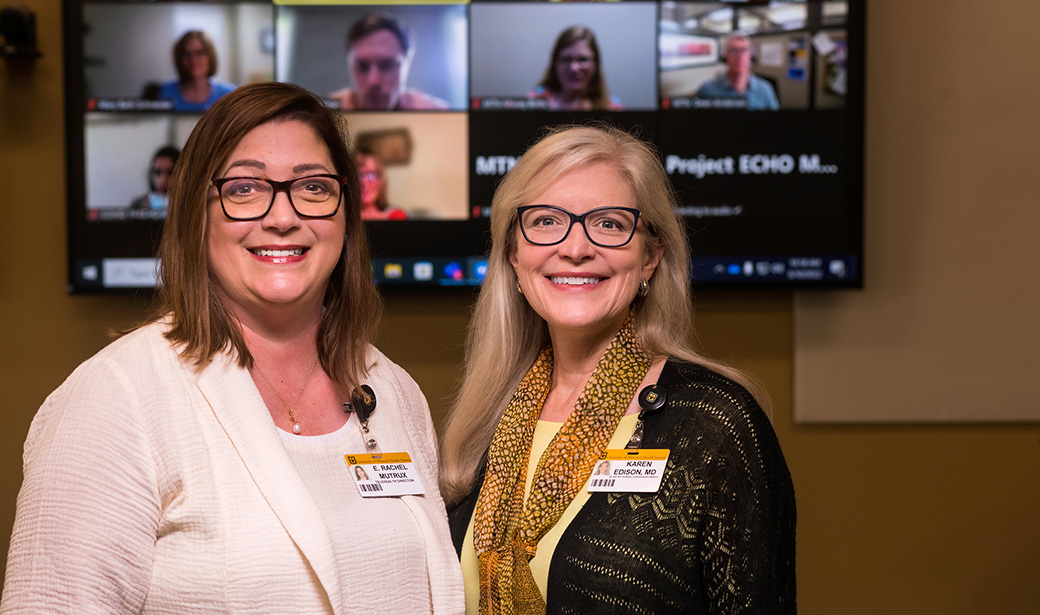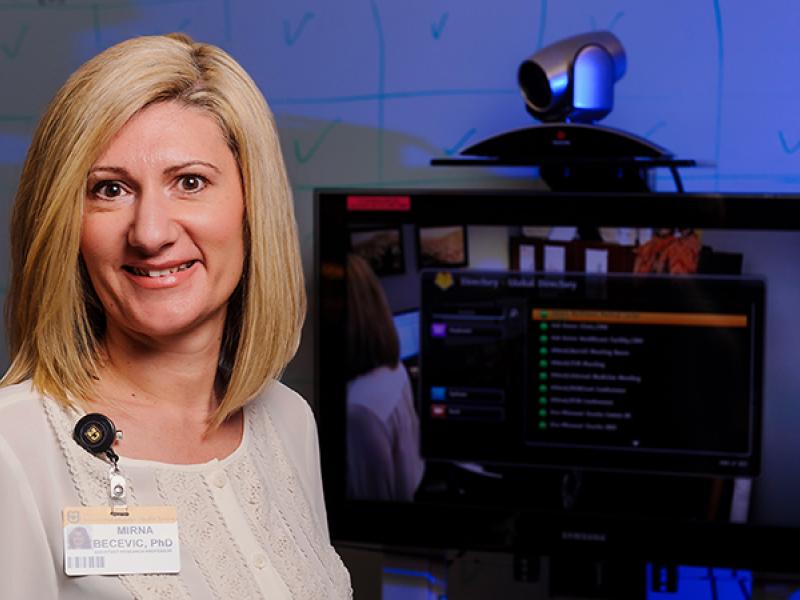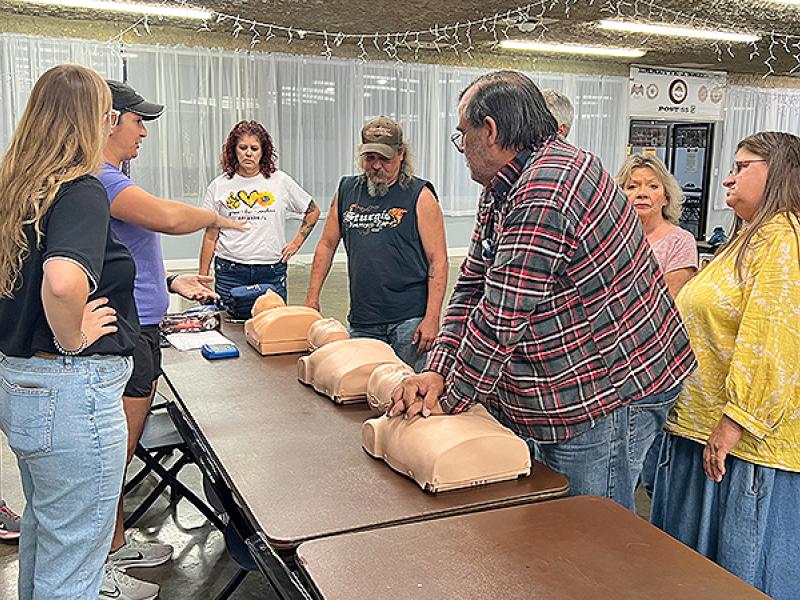
When Karen Edison, MD ’89, began her career as a dermatologist, she assumed as long as there were cars and roads, people from distant parts of Missouri would drive to Columbia or other cities for important appointments. All it took to change her mind was getting in her own car and driving to Moberly to hold outreach clinics.
Early on, she saw a man in his 80s who had skin cancer on his eyelid, and she told him he needed to come to Columbia for treatment.
“He listened politely and said, ‘Yeah, I understand all that, Doc, but I can’t drive, all my friends are dead and my kids are two hours away. I’m not going to Columbia,’” Edison recalled. “That sort of thing happened a lot. I quickly realized there are all kinds of people who don’t travel for health care.”
In 1995 — back in the days of dial-up internet service — Edison joined the Missouri Telehealth Network (MTN), a program based at the MU School of Medicine that is devoted to using technology to bring health care to rural and underserved people throughout the state. In the beginning, executing that vision meant providing bulky teleconferencing units to Federally Qualified Health Centers around Missouri so patients could go to their local clinic and be seen virtually by specialists.
“I would go around the state and try to talk people into using it,” said Edison, who retired as chair of the Department of Dermatology in 2019 but continues as the MTN senior medical director. “Most providers — if they used it and it worked well and they could see the value to their patients — would keep using it.”
The Age of ECHO
In 2014, MTN started Show-Me ECHO, which was modeled after an innovative program called Project ECHO that began at the University of New Mexico. It’s a way to help primary care clinicians and other professionals learn from experts in various specialties — and from each other — during lunch-hour videoconferences in which a participant presents a real case for discussion and recommendations.
Show-Me ECHO, which stands for Extension for Community Healthcare Outcomes, started with two ECHOs on the topics of autism and pain management. It’s grown to 38 topics, and MTN has become one of 14 superhubs worldwide that teach other organizations how to start their own ECHOs.
A good example of how the program works can be found in Hannibal. Tonya Stamper, DNP, a nurse practitioner for Clarity Healthcare, was seeing a surge in patients with hepatitis C sparked by the opioid epidemic. Three years ago, she started participating in hepatitis C ECHOs to ask specific questions, such as how antiviral treatments could interact with other medications, whether they were safe for a breastfeeding mom or whether they were causing an abnormal lab result.
The sessions gave her confidence to know she was making the right decisions. In February 2022, she cured her 100th patient with hepatitis C.
“What I’ve learned in ECHOs, I’ve been able to apply to every hep C patient,” Stamper said. “The outcomes are so amazing. I have folks coming in who feel like they’ve made so many bad choices throughout their lives, and now they have this disease that they’re not sure if they’ll be able to get rid of. Even if they’re in recovery, this is hanging over their head. When I say, ‘We can cure this, and you can put this behind you,’ they are so grateful that what they might have thought was a death sentence doesn’t have to be.”
In the northwest corner of Missouri, Jerry Wilmes, MD ’87, is a family medicine physician in Maryville who has participated in ECHOs on multiple topics, including mental health. He was the longtime director of student health at Northwest Missouri State University, so he saw many students dealing with anxiety and depression who would have to wait months to see a psychiatrist. By presenting cases on the psychiatry ECHO, Wilmes learned whether he could manage the patient’s medications or whether he needed to get the patient to a higher level of care.
“I’ve spent almost my entire career in rural areas, but personally I need the collegiality and intellectual stimulation of staying in touch with what is going on,” Wilmes said. “When the ECHO concept came out, I thought, ‘Holy cow, this is it.’ I always said I wanted this and needed this, but I didn’t want to move to a city. You’re interacting with subject matter experts and colleagues from across the state. I hate to sound dramatic, but it’s been a godsend for me.”
Breaking Down Barriers
With the help of ECHOs, the size and scope of MTN continued to grow. But the biggest leap in telehealth happened out of necessity when COVID-19 arrived. In 2020, the U.S. Department of Health and Human Services changed a number of telehealth rules to encourage doctors to treat patients remotely during the pandemic. That meant patients could receive telehealth anywhere, including their homes, and didn’t need to have an established relationship with a doctor first. Providers were now free to connect with patients through Zoom, FaceTime or Skype.
Nationwide, the number of Medicare-billed telehealth visits jumped from 840,000 in 2019 to 52.7 million in 2020.
“We have never been as popular as we were in 2020,” said Rachel Mutrux, MTN’s director. “Before the pandemic, most providers hadn’t done any telehealth visits. Now, most providers have. With the public health emergency order, it really opened up the ability for health care providers because there were true barriers to telehealth before the pandemic.”
Another barrier to telehealth for some Missourians is lack of access to broadband internet, either because it isn’t available in their area or they can’t afford it. To address that problem in 2020, MTN partnered with the Missouri Department of Economic Development and three telecom companies to deliver Wi-Fi hotspots to Missourians who needed them for telehealth appointments. The hotspots went to Federally Qualified Health Centers and community mental health centers, who identified the people who needed them most and distributed them.
“We were able to get more than 9,000 hotspots in the hands of patients and clinicians, because some clinicians live in remote places where they don’t have good internet access either,” Mutrux said.
In the future, as technology and internet access continue to improve, Edison estimated that at least 20% of all medical appointments will be handled through telehealth.
“Patients realize that you can get your health care needs met from your home,” she said. “It’s been particularly useful for mental and behavioral health, parents of small children, the elderly and people with disabilities. There are certain groups of people that have a hard time going to a visit, and telehealth into the home is very important.”





